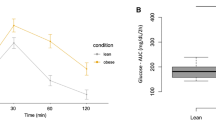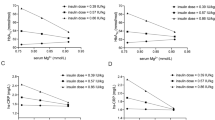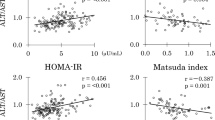Abstract
The relationship between basal serum tumor necrosis factor alpha (TNFα) levels and peripheral tissue (muscle) sensitivity to insulin was examined in 63 subjects with normal glucose tolerance (NGT), 18 subjects with impaired glucose tolerance (IGT), and 123 patients with type 2 diabetes mellitus (T2DM). The BMI was similar in NGT (28.8±0.7 kg/m2), IGT (31.1±1.0), and T2DM (30.0±0.4) groups. The fasting serum TNFα concentration in T2DM (4.4±0.2 pg/ml) was significantly higher than in NGT (3.1±0.2) and IGT (3.4±0.2; both P<0.05). In T2DM the fasting plasma glucose (FPG=183±5 mg/dl) and insulin (FPI=17±1 µU/ml) concentrations were significantly higher than in NGT (FPG=95±1; FPI=10±1) and IGT (FPG=100±2; FPI=13±1; all P<0.01). The rate of total body insulin-mediated glucose disposal (Rd; 40 mU/m2 min euglycemic insulin clamp in combination with 3H-glucose) was reduced in T2DM (102±3 mg/m2 min) compared with NGT (177±10) and IGT (151±14; both P<0.01). The serum TNFα concentration was inversely correlated with Rd (r=−0.47, P<0.0001) and positively correlated with both FPG (r=0.32, P=0.004) and FPI (r=0.32, P=0.004) in NGT plus IGT. No correlation was observed between serum TNFα and Rd (r=−0.02), FPG (r=0.15), or FPI (r=0.15) in T2DM. In stepwise multiple regression analysis using age, sex, BMI, FPG, FPI and serum TNFα concentration as independent variables, only BMI and serum TNFα concentration were significant and independent predictors of Rd (r2=0.29, P<0.0001) in the NGT plus IGT group, while FPG and FPI were significant and independent predictors of Rd (r2=0.13, P<0.0001) in T2DM. These results suggest that: (i) an increase in circulating TNFα concentration is associated with peripheral insulin resistance and increased plasma glucose and insulin levels prior to the onset of type 2 diabetes; and (ii) the further deterioration in peripheral insulin resistance in T2DM (compared with NGT and IGT) is unrelated to the increase in serum TNFα concentration.
This is a preview of subscription content, access via your institution
Access options
Subscribe to this journal
Receive 12 print issues and online access
$259.00 per year
only $21.58 per issue
Buy this article
- Purchase on Springer Link
- Instant access to full article PDF
Prices may be subject to local taxes which are calculated during checkout



Similar content being viewed by others
References
DeFronzo RA & Ferrannini E . Insulin resistance: a multifaceted syndrome responsible for NIDDM, obesity, hypertension, dyslipidemia, and atherosclerotic cardiovascular disease. Diabetes Care 1991; 14: 173–194.
Hamman RF . Genetic and environmental determinations of non-insulin dependent diabetes mellitus (NIDDM). Diabetes Metab Rev 1992; 8: 287–338.
Pi Sunyer FX . Medical hazards of obesity. Ann Intern Med 1993; 119: 655–660.
Hotamisligil GS, Arner P, Caro JF, Atkinson RL & Spiegelman BM . Increased adipose tissue expression of tumor necrosis factor-alpha in human obesity and insulin resistance. J Clin Invest 1995; 95: 2409–2415.
Hotamisligil GS & Spiegelman BM . Tumor necrosis factor α: a key component of the obesity-diabetes link. Diabetes 1994; 43: 1271–1278.
Hotamisligil GS, Shargill NS & Spiegelman BM . Adipose expression of tumor necrosis factor alpha: a direct role in obesity-linked insulin resistance. Science 1993; 259: 87–91.
Kern P, Saghizadeh M, Ong J, Bosch R, Deem R & Simsolo R . The expression of tumor necrosis factor in human adipose tissue. Regulation by obesity, weight loss, and relationship to lipoprotein lipase. J Clin Invest 1995; 95: 2111–2119.
Hotamisligil GS, Murray DL, Choy LN & Spiegelman BM . Tumor necrosis factor α inhibits signaling from insulin receptor. Proc Natl Acad Sci USA 1994; 91: 4854–4858.
Feinstein R, Kanety H, Papa M, Lunenfeld B & Karasik A . Tumor necrosis factor α suppress insulin-induced tyrosine phosphorylation of insulin receptor and its substrates. J Biol Chem 1993; 268: 26055–26058.
Kanety H, Feinstein R, Papa MZ, Hemi R & Karasik A . Tumor necrosis factor alpha-induced phosphorylation of insulin receptor substrate-1 (IRS-1). Possible mechanism for suppression of insulin-stimulated tyrosine phosphorylation of IRS-1. J Biol Chem 1995; 270: 23780–23784.
Ofei F, Hurel S, Newkirk J, Sopwith M & Taylor R . Effects of an engineered human anti-TNFα antibody (CDP571) on insulin sensitivity and glycemic control in patients with NIDDM. Diabetes 1996; 45: 881–885.
Scheen AJ, Castillo MJ, Paquot N, Lefebve PJ & Belgium L . Neutralization of TNFα in obese insulin resistant human subjects: no effect on insulin sensitivity. Diabetes 1996; 45 (Suppl 2): 286A
Nilsson J, Jovinge S, Niemann A, Reneland R & Lithell H . Relationship between plasma tumor necrosis factor α and insulin sensitivity in elderly men with non-insulin-dependent diabetes mellitus. Arterioscler Thromb Vasc Biol 1998; 18: 1199–1202.
Katsuki A, Sumida Y, Murashima S, Murata K, Takarada Y, Ito K, Fujii M, Tsuchihashi K, Goto H, Nakatani K & Yano Y . Serum levels of tumor necrosis factor-α are increased in obese patients with noninsulin-dependent diabetes mellitus. J Clin Endocrinol Metab 1998; 83: 859–862.
Zinman B, Hanley AJG, Harris SB, Kwan J & Fantus IG . Circulating tumor necrosis factor-α concentrations in a native Canadian population with high rates of type 2 diabetes mellitus. J Clin Endocrinol Metab 1999; 84: 272–278.
Report of the expert committee on the diagnosis and classification of diabetes mellitus. Diabetes Care 1997; 20: 1183–1197.
DeFronzo RA, Tobin JD & Anders R . Glucose clamp technique: a method for quantifying insulin secretion and resistance. Am J Physiol 1979; 237: E214–E223.
Steele R . Influence of glucose loading and of injected insulin on hepatic glucose output. Ann NY Acad Sci 1959; 82: 420–430.
DeFronzo RA . Pathogenesis of type 2 diabetes: metabolic and molecular implications for identifying diabetes genes. Diabetes Rev 1997; 4: 177–269.
Rossetti L, Giaccari A & DeFronzo RA . Glucose toxicity. Diabetes Care 1990; 13: 610–630.
Iozzo P, Pratipanawatr T, Pijl H, Vogt C, Kumar V, Pipek R, Matsuda M, Mandarino L, Cusi K & DeFronzo RA . Physiologic hyperinsulinemia improves insulin-stimulated glycogen synthase activity and glycogen synthesis. Am J Physiol 2001; 280: E712–E719.
Boden G . Role of free fatty acids in the pathogenesis of insulin resistance and NIDDM. Diabetes 1997; 46: 3–10.
Mishima Y, Kuyama A, Tada A, Takahashi K, Ishioka T & Kibata M . Relationship between tumor necrosis factor-α and insulin resistance in obese men with type 2 diabetes mellitus. Diabetes Res Clin Pract 2001; 52 (Suppl 2): 119–123.
Mohamed-Ali V, Goodrick S, Rawesh A, Katz DR, Miles JM, Yudkin JS, Klein S & Coppack SW . Subcutaneous adipose tissue releases interleukin-6, but not tumor necrosis factor-α. in vivo. J Clin Endocrinol Metab 1997; 82: 4196–4200.
Cornelius P, Lee MD, Marlow M & Pekala PH . Monokine regulation of glucose transporter mRNA in L6 myotubes. Biochem Biophys Res Commun 1989; 165: 429–436.
Cheung AT, Ree D, Kolls JK, Fuselier J, Coy DH & Bryer-Ash M . An in vivo model for elucidation of the mechanism of tumor necrosis factor-α (TNF-α)-induced insulin resistance: evidence for differential regulation of insulin signaling by TNF-α. Endocrinology 1998; 139: 4928–4935.
Uysal KT, Wiesbrock SM, Marino MW & Hotamisligil GS . Protection from obesity-induced insulin resistance in mice lacking TNF-α function. Nature 1997; 389: 610–614.
Bemelmans MHA, Van Tis LJH & Buurman WA . Tumor necrosis factor: function, release and clearance. Crit Rev Immunol 1997; 16: 1–11.
Pickup JC, Mattock MB, Chusney GD & Burt D . NIDDM as a disease of the innate immune system: association of acute-phase reactants and interleukin-6 with metabolic syndrome X. Diabetologia 1997; 40: 1286–1292.
Hotamisligil GS, Budavari A, Murray D & Spiegelman BM . Reduced tyrosine kinase activity of the insulin receptor in obesity-diabetes. Central role of tumor necrosis factor-α. J Clin Invest 1994; 94: 1543–1549.
Kolls J, Peppel K, Silva M & Beutler B . Prolonged and effective blockade of TNF activity through adenovirus-mediated gene transfer. Proc Natl Acad Sci 1994; 91: 215–219.
Lonnqvist F, Wennlund A & Arner P . Relationship between circulating leptin and peripheral fat distribution in obese subjects. Int J Obes Relat Metab Disord 1997; 21: 255–260.
Considine RV, Sinha MK, Heiman ML, Kriauciunas A, Stephens TW, Nyce MR, Ohannesian JP, Marco CC, McKee LJ & Bauer TL . Serum immunoreactive-leptin concentrations in normal-weight and obese humans. New Engl J Med 1996; 334: 292–295.
Barzilai N, Wang J, Massilon D, Vuguin P, Hawkins M & Rossetti L . Leptin selectively decreases visceral adiposity and enhances insulin action. J Clin Invest 1997; 100: 3105–3110.
Dandona P, Weinstock R, Thusu K, Abdel-rahman A, Aljada A & Wadden T . Tumor necrosis factor-α in sera of obese patients: Fall with weight loss. J Clin Endocrinol Metab 1998; 83: 2907–2910.
Kern PA, Saghizadeh M, Ong JM, Bosch RJ, Deem R & Simsolo RB . The expression of tumor necrosis factor in human adipose tissue. J Clin Invest 1995; 95: 2111–2119.
Arner P . Regional differences in protein production by human adipose tissue. Biochem Soc Trans 2001; 29: 72–75.
Van Harmelen V, Reynisdottir S, Eriksson P, Thörne A, Hoffstedt J, Lönqvist F & Arner P . Leptin secretion from subcutaneous and visceral adipose tissue in women. Diabetes 1998; 47: 913–917.
Tsigos C, Kyrou I, Chala E, Tsapogas P, Stavridis JC, Raptis SA & Katsilambros N . Circulating tumor necrosis factor alpha concentrations are higher in abdominal versus peripheral obesity. Metabolism 1999; 48: 1332–1335.
Saghizadeh M, Ong JM, Garvey WT, Henry RR & Kern PA . The expression of TNFα by human muscle. Relationship to insulin resistance. J Clin Invest 1996; 97: 1111–1116.
Morohoshi M, Fujisawa K, Uchimura I & Numano F . Glucose-dependent interleukin 6 and tumor necrosis factor production by human peripheral blood monocytes in vitro. Diabetes 1996; 45: 954–959.
Iida KT, Shimano H, Kawakami Y, Sone H, Toyoshima H, Suzuki S, Asano T, Okuda Y & Yamada N . Insulin up-regulates tumor necrosis factor-α production in macrophages through an extracellular-regulated kinase-dependent pathway. J Biol Chem 2001; 276: 32531–32537.
Chung HY, Kim HJ, Kim JW & Yu BP . The inflammation hypothesis of aging. Molecular modulation by caloric restriction. Ann NY Acad Sci 2001; 928: 327–335.
Acknowledgements
The authors gratefully acknowledge the nursing assistance of John Kincade, James King, Diane Frantz and Magda Ortiz, the technical assistance of Kathy Camp, Sheila Taylor and Cindy Munoz, and the secretarial assistance of Elva Gonzales and Lorrie Albarado.
Author information
Authors and Affiliations
Corresponding author
Rights and permissions
About this article
Cite this article
Miyazaki, Y., Pipek, R., Mandarino, L. et al. Tumor necrosis factor α and insulin resistance in obese type 2 diabetic patients. Int J Obes 27, 88–94 (2003). https://doi.org/10.1038/sj.ijo.0802187
Received:
Revised:
Accepted:
Published:
Issue Date:
DOI: https://doi.org/10.1038/sj.ijo.0802187
Keywords
This article is cited by
-
Correlation of Diabetes Related Factors with Vitamin D and Immunological Parameters in T2DM Kashmiri Population
Indian Journal of Clinical Biochemistry (2023)
-
Brown adipose tissue-derived MaR2 contributes to cold-induced resolution of inflammation
Nature Metabolism (2022)
-
C1q/TNF-related protein 4 restores leptin sensitivity by downregulating NF-κB signaling and microglial activation
Journal of Neuroinflammation (2021)
-
Egg white hydrolysate and peptide reverse insulin resistance associated with tumor necrosis factor-α (TNF-α) stimulated mitogen-activated protein kinase (MAPK) pathway in skeletal muscle cells
European Journal of Nutrition (2019)
-
Regulation of aging and oxidative stress pathways in aged pancreatic islets using alpha-lipoic acid
Molecular and Cellular Biochemistry (2018)



